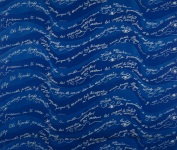THE SEVENTIES:HAPPINESS
In 1970, the first centenary of the birth of Hoffmann and Loos, Gio Ponti was approaching eighty. In these closing years of his life he would complete two master works, Taranto Cathedral, 1970, and the Denver Museum, 1971. He also came up with a new object (an armchair of little seat, 1971) and a new way of designing fabrics (1970), tile floors (1976), and tile facades (1978). He wrote, drew, and listened. His thoughts, at this time, turned more and more around the home, around the act of living in a house. But his proposal of a versatile house with movable walls, never taken up, was something that went beyond the realm of design; it was the expression of a mode of thinking and living that was his final message, the one that he had always been trying to convey. The house should be a simple affair. This can be judged from the degree of delight that one experiences when looking at it from the outside, and from the degree of delight that one experiences from living in it. Gio Ponti was alone in thinking in this way, in the hubbub of that time, 1971.
From "Gio Ponti, l'opera" by Lisa Licitra Ponti,1990, Leonardo Editore


















